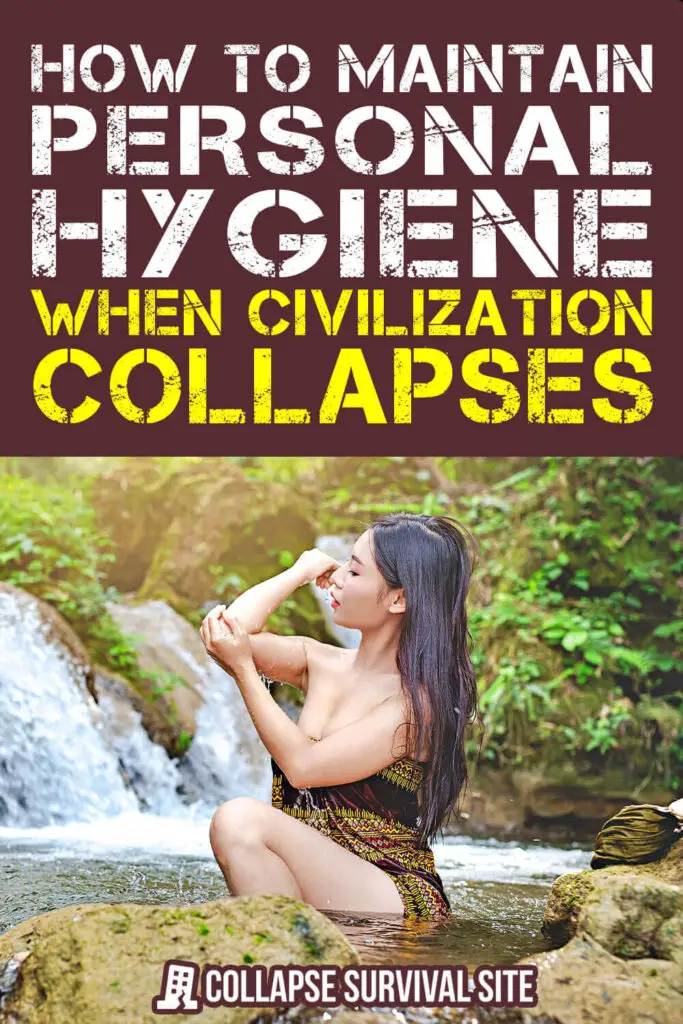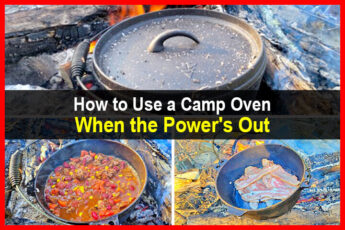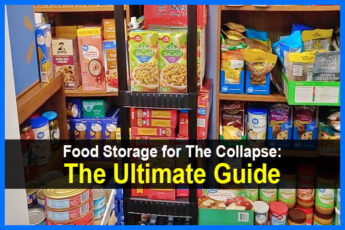Estimated reading time: 16 minutes
Anyone who has experienced a power outage is familiar with the dramatic lifestyle changes that come with a time without electricity, heat and especially water. With any luck the outage is short-term, but long-term outages are becoming more and more common.
But there’s a bigger threat beyond the outages that often accompany major storms. It’s the impact of a collapse of society and the civilized world as we know it.
Want to save this post for later? Click Here to Pin It On Pinterest!
The Impacts
Beyond all of the reasons that a collapse could occur are the measurable impacts of the failure of society. In countries around the world societal collapse has quickly led to the loss of basic services, medical aid and facilities, even fundamental needs like grocery stores and gas stations are often shuttered and closed.
It’s also no surprise that services related to communication, power generation and local water supplies rapidly diminish or simply disappear. Some people will be prepared while others will struggle with the most basic necessities.
But even the well prepared sometimes overlook some of the simple and complex needs related to basic hygiene. Our tendency is to prioritize food, water, firearms and first aid with hygiene a sometimes distant next step.
As far as hygiene is concerned, it’s too easy for some to assume that’s the least of their worries when the world if falling apart around them. But if you look at countless societies and civilizations that have endured a collapse, it’s not an overnight event. It happens slowly and life does go on.
It’s all a question of how miserable you want to be or not. Those who avoid the most misery know how to avoid infection and disease that can make a miserable time worse. Those who know, find ways to maintain a decent level of personal hygiene.
And There’s More to It than Just Water
Finding a reliable source of water when the wells are without electricity and municipal supplies have run dry will always be a critical priority. But we often think of it as the need to find, purify and store “drinking” water. That makes sense and we can’t survive past 3 days without it, but think about how much water you use on a daily basis.
According to watercalculator.org, the average person uses 60 gallons of water a day. Of that amount 84% is used for personal hygiene. That’s about 50 gallons although our usage in a survival situation will be very different than our everyday usage. Even then, some things related to hygiene cannot be done without water.
Hygiene Defined
It starts with personal cleanliness whether it be a shower, bath, tooth brushing, or toilet flushing. But there are other things that need to be clean like laundry, dishes and even counter tops. The immediate challenge is to find enough additional water to store or learn to use creative alternatives for all of your personal hygiene.
Let’s Start with Water
Stockpiling food is easier than stockpiling water. Water occupies a lot of space, is heavy and the average adult needs at least a gallon a day just to survive. Do the math and water storage becomes a challenging task without eventual replenishment. Stockpile water if you can but know that all stockpiles can eventually be exhausted –especially water.
Consider Available Water Resources
Some people are lucky and live in close proximity to a pond, lake, creek or river. Those people can harvest water fairly easily and their biggest challenge is filtration, purification and some level of storage for purified water.
People far from natural water sources are more dependent on rainfall and the ability to harvest and store the rain. Rain should also be purified before drinking, but many other uses like laundry and dishwashing could use straight rainwater without the added filtration step. But there’s a problem…
It Doesn’t Always Rain a Lot
Many parts of the world are enduring long-term droughts. Droughts eventually end but if you live far from a natural water source, and are largely dependent on rain water you do not have a reliable resource. Even robust storage of rain water will eventually run out. That’s when we have to get creative and there are numerous new and time-tested solutions.
Bathing
The easiest solution is to do what people have been doing for thousands of years. Take a bath in a natural water source like a creek, river or lake. Creeks and rivers have the benefit of a current to wash away the grime and any soap. Of course that will send it downstream but if it’s just a few people taking a quick natural bath the impact won’t be as much.
Springs and creeks are often the purest especially close to the source. Rivers have the potential to pick up a lot of contamination and the larger the river, the larger the risk of pollutants.
Another solution is to take advantage of those times when it rains. Collecting it is always a good idea but a quick shower under a drain pipe will not only let you soap up but get a good rinse as well.
If you find that collecting rainwater is your best or only solution for harvesting water you should invest in a couple of items. One is a downspout that attaches to a rain gutter to direct the water into a barrel or onto your head if it’s shower time.
You can connect a hose and it has a valve that allows you to direct the water into the barrel or back down the drain. Speaking of barrels…
There are specialized barrels designed to catch and store rainwater. Most have a spigot at the bottom to make it easy to tap the water you’ve captured for use or purification. That spigot could also serve as an easy way to take a shower if the barrel is elevated above ground level.
Take a Pioneer Bath
Our pioneer ancestors would often fill a tub with water and take a handmade bath. Sometimes other members of the family would share the same bathwater soon after with the dirtiest person going last. Reusing this “grey water” to give the dog a quick bath is another idea. And when all of the baths are done, dump the bathwater into the garden.
Well pumps
If both natural water resources and rainfall are limited or unavailable, you can always dig a well or have one installed. Installation is better done sooner than later but an above ground well pump can be the best solution to any water shortages. You should test your well water to make sure it has minimum purity levels and hopefully droughts won’t make your well run dry.
What about Hot Water?
There are a few solutions from a time without water heaters. A classic pioneer solution was a wood-burning cookstove with a 3 to 35 gallon water reservoir attached to the side of the stove.
As the stove burned to heat the house and cook the family meals, the heat also warmed the water in the reservoir for dishes, laundry and of course filling that pioneer bathtub.
Another Solution is Called a “Solar Shower”
A solar shower often shows up at long-term campsites and a tarp wrapped around a few trees makes for a private shower outdoors. The shower bag is filled with water and hung in the sun where the UV rays of the sun heat the water. Gravity allows for a flow of water although it’s recommended you lather up first before releasing the limited amount of water.
And Then There’s Soap
A bar of soap can take you a long way towards staying clean. Not only to wash away dirt and grime but its surfactant properties wash away germs, can be used as shampoo to wash your hair and soap bars were often used to do laundry.
A good stockpile is easy to do and inexpensive and there are many ways that you can make your own soap.
Would You Believe –A Dry Bath?
If you’re one of those people who think ahead you can always stockpile a product literally known as a “dry bath.” It’s a product that allows you to clean up with a gel that you wipe off. Think of it as hand sanitizer for your whole body. It’s a product often used for people who are bed-ridden or for remote expeditions where water is simply unavailable for bathing.
If you forgot to stockpile your dry bath you can improvise your own. Here’s a video that gives you a formula and step by step process.
No Rinse Shampoo
Believe it or not, you can wash your hair without water. You work the shampoo into and through your hair and dry with a towel. The manufacturer claims that it leaves hair as clean as a traditional shampoo and water rinse. If you want to make your own, here’s the recipe:
DIY Dry Shampoo Spray Ingredients:
- ½ cup distilled water
- 2 tablespoons arrowroot powder
- 2 tablespoons vodka
- 3 drops lavender essential oil
- 2 drops rosemary essential oil
- 1 fine mist 5-ounce spray bottle
Disinfectant Wipes
Disinfectant wipes are the best solution for cleaning up any surfaces that may contain bacteria or viruses at a time without water. They’re not intended for use on the skin but for all of those things that surround us; these will keep the area germ-free.
If you want to make your own, here’s the formula:
DIY Disinfecting Wipes
- 2 cups Distilled water
- 1 cup isopropyl alcohol (at least 70% concentration)
- 1 tablespoon Dawn dish soap
- 3 drops Tea tree oil (optional)
- 1 Paper Towel Roll
Cut the paper towel roll in half with a serrated knife, and put it in an old Clorox wipes container or large jar. Mix up all the other ingredients and pour over the paper towel roll.
If you want to use a disinfectant on your skin, consider the next couple of possibilities.
Baby Wipes
Baby wipes can be used on the skin and if they’re good enough to clean up a baby they’ll work for the rest of us. In an emergency, here’s how you can make your own:
DIY Baby Wipes
Ingredients:
- 1 paper towel roll (preferably a thicker option)
- 3 tablespoons of oil (either coconut, olive, or almond)
- 2 tablespoons of unscented soap (Dr. Bronner’s is a good option, she says)
- 4 cups of water (should first be boiled for about two minutes in order to disinfect)
- Optional: Aloe vera (in order to prevent a diaper rash)
Instructions:
- Lay down the paper towel roll and cut it in half
- Place one half of the paper towel roll in a waterproof container
- Mix the oil, unscented soap, and water (and aloe vera if desired) together
- Pour the mixture over the paper towel half
- Let it soak through and then remove from the container
This will last about four to five days. Keep in mind, these can get moldy pretty easily, so it’s not required to presoak. You can always put the mixture into a spray bottle, and you can just spray the paper towel as needed.
Hand Sanitizer
Next to toilet paper it’s a good bet that a lot of us have plenty of hand sanitizer still around. And it’s not just for hands. Hand sanitizer is usually a combination of rubbing alcohol and aloe vera lotion.
The formulas vary but most homemade hand sanitizer recipes use that combination. The alcohol cleans and kills germs and the aloe vera soothes and further cleanses skin surfaces. Don’t leave home without it.
Vinegar
Vinegar has been used as a cleaning agent for thousands of years, even before the concept of bacteria was understood. Something as simple as vinegar in water can make for a cleansing bath in case you’re out of soap or don’t know how to make your own.
Better yet, apple cider vinegar works just as well and cider vinegar is easy to make.
Baking Soda
Baking soda is often touted as the go-to solution for everything in a survival situation. Here are just some of the personal hygiene uses for baking soda:
- Toothpaste – A paste made from baking soda and a 3 percent hydrogen peroxide solution can be used as an alternative to commercial non-fluoride toothpastes. You can also just dip your toothbrush with toothpaste into baking soda for an extra boost.
- Mouthwash – Put one teaspoon in half a glass of water, swish, spit and rinse. Odors are neutralized, not just covered up.
- Soak Oral Appliances – Soak oral appliances, like retainers, mouthpieces and dentures, in a solution of 2 teaspoons baking soda dissolved in a glass or small bowl of warm water. The baking soda loosens food particles and neutralizes odors to keep appliances fresh. You can also brush appliances clean using baking soda.
- Use as a Facial Scrub and Body Exfoliate – Give yourself an invigorating facial and body scrub. Make a paste of 3 parts baking soda to 1 part water. Rub in a gentle circular motion to exfoliate the skin. Rinse clean. This is gentle enough for daily use.
- Deodorant – Pat baking soda onto your underarms to neutralize body odor.
- Hand Cleanser and Softener – Skip harsh soaps and gently scrub away ground-in dirt and neutralize odors on hands with a paste of 3 parts baking soda to 1 part water, or 3 parts baking soda to gentle liquid hand soap. Then rinse clean. You can try this honey and cornmeal scrub for hands too.
- Make a Bath Soak – Add 1/2 cup of baking soda to your bath to neutralize acids on the skin and help wash away oil and perspiration; it also makes your skin feel very soft.
- Soothe Your Feet – Dissolve 3 tablespoons of baking soda in a tub of warm water and soak feet. Gently scrub.
Body Lotions and Exfoliates
Skincare is a big part of personal hygiene and good supply of basic moisturizers and body lotions makes sense. This is another product you could also make yourself. When things around you are in disarray the ability to do it yourself will become a common task.
Dental Hygiene
There’s a good possibility that professional dental care will be difficult to find. That’s all the more reason to take the time to find ways to care for your teeth. Toothpaste may be hard to find if you haven’t stockpiled sufficient quantities and once again, stockpiles eventually run out.
You can make your own toothpaste and even improvise a toothbrush. It’s also possible to make your own mouthwash. Something that could complicate things are more extreme dental problems. There’s an excellent book written by a missionary titled Where There Is No Dentist. It covers ways to treat dental emergencies from cracked teeth to lost or loose fillings.
A dental first aid kit makes sense but from a hygiene standpoint one of the most direct solutions is to simply stockpile mouthwash. And make sure you know how to improvise anything else you’ll need as time goes on and supplies run out. Here’s a DIY mouthwash recipe:
Basic Mouthwash
- 1 cup of filtered water
- 4 teaspoons of baking soda
- 4 drops of tea tree essential oil
- 4 drops of peppermint essential oil
Add all these ingredients together in a mason jar or similar container with a lid. Shake very well.
Use about 2 tablespoons of this mixture each day, the same way you would use mouthwash for super white teeth and fresh breath. The baking soda will usually settle to the bottom of the container after a few hours, but don’t worry, this is normal. Simply shake well before each use.
Cuts, Wounds and Infections in General
If ever a situation called for hygiene it’s when someone gets a cut, wound, burn or any other invasive injury that draws blood. A time after the collapse is a dirty time to put it bluntly. The possibility for infection is significantly increased and any wound should be treated as an urgent care situation.
In addition to following first aid advice for cuts and wounds, both a good stockpile of a triple antibiotic like Neosporin and the ability to make your own is critical. Any cut or wound has the potential to get infected and after a collapse of society the odds simply go up.
Toilet
You can use grey water to flush a toilet when the water’s not working but even grey water runs out. One solution many people turn to is a composting toilet. It’s a small version of an outhouse that encourages wastes to decompose, and if properly maintained can be odor free.
You can buy them or make your own. Human waste is a bacterial Petri dish and is responsible for more water borne diseases than any other cause. Toilet paper or its alternatives are also important and anywhere you have a toilet may be a very good place to keep a bottle of hand sanitizer.
Laundry
In the grand scheme of things it seems like we could go a few days without doing the laundry but don’t count on it. Tough times are laborious times and the potential for clothes, particularly socks and underwear, to get seriously soiled is vastly multiplied.
Unfortunately, there are no dry solutions for laundry. You’ll need to use some water but washing by hand can allow you to conserve water. You’ll probably need to wash by hand regardless of the situation. Typically, more water is used to rinse clothes than to suds them up. Try to use as little water as possible with your soap or detergent and save your precious water for rinsing and wringing.
Don’t forget to reuse your grey water from your laundry efforts for your garden, washing equipment or even washing the floors.
Doing the Dishes
Next to the threat of water borne illness are the food borne illnesses. What we sometimes neglect is that we are used to eating on spotlessly clean dishes. That all changes when water is scarce and pure water is precious.
The standard advice is to fill the sink with soap and water and turn off the faucet while cleaning. After you've filled the basin, don't let water go down the drain unless you're using it to rinse off suds.
You can use a stream of water from a plastic water bottle with a small hole drilled in the cap to minimize your rinse water usage. Better yet, minimize your use of dishes, pots and pans as much as possible.
And Then There’s the Garbage
If you’ve ever seen a city after a garbage strike you’ll appreciate the sanitation hazard that garbage can represent. When there is no garbageman you’re on your own. The proliferation of garbage is another reason a collapsed society is rife with threats to hygiene. The solutions are coarse and there are no guarantees that everyone will follow them. Here are some common tips:
- Compost any and all organic materials in a compost heap.
- Burn any bones, leftover meat, oils or fats (If you can). Otherwise, bury it.
- Burn paper, cardboard or any other cellulose based or carbon based materials.
- Upcycle plastics and synthetics as much as possible. When you have no choice –bury plastics and synthetics.
- Determine whether or not a local dump has been established. You may have to cart it there yourself but it may be the only alternative. It could also be a potential destination for salvaged materials.
What’s critical with garbage is to avoid any cross-contamination from a garbage source with your water supplies, gardens or as much as possible -yourself.
Feminine Hygiene
Feminine hygiene is a highly personal task. A stockpile of tampons if often identified as a valuable barter resource. There are also natural, recycled and primitive alternatives that can be improvised as feminine pads.
Pets
Pet hygiene is just as important as your family hygiene practices. Your pets live with you and their level of cleanliness and health will directly affect you. Take the same hygiene steps with your pet that you would take with yourself. Additionally, keep them brushed, and check their ears, eyes, and body for any problems. In other words, do what you always do with your pets.
A Bug Out Hygiene Kit
In the event that you have to evacuate you should isolate many of the items we’ve already identified, and pack what you can carry or fit in your vehicle. You can also buy preassembled survival hygiene kits. Obviously you’ll have to balance that with other things you’ll need but don’t forget about personal hygiene.
What may be your greatest asset whether you’re home or on the road are the knowledge and the skills to improvise your own solutions. This applies to everything you need to survive and certainly applies to the needs for hygiene as well.
Like this post? Don't Forget to Pin It On Pinterest!








